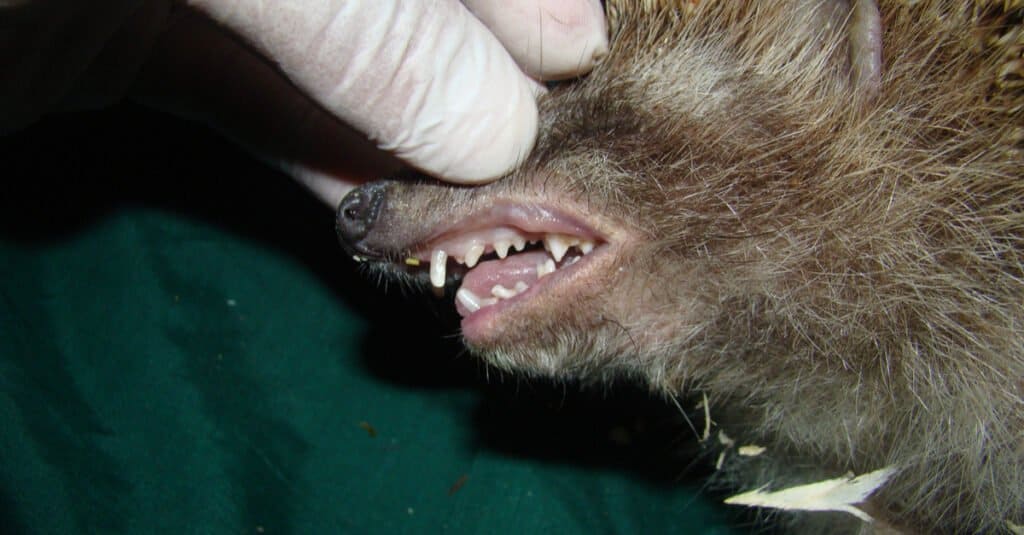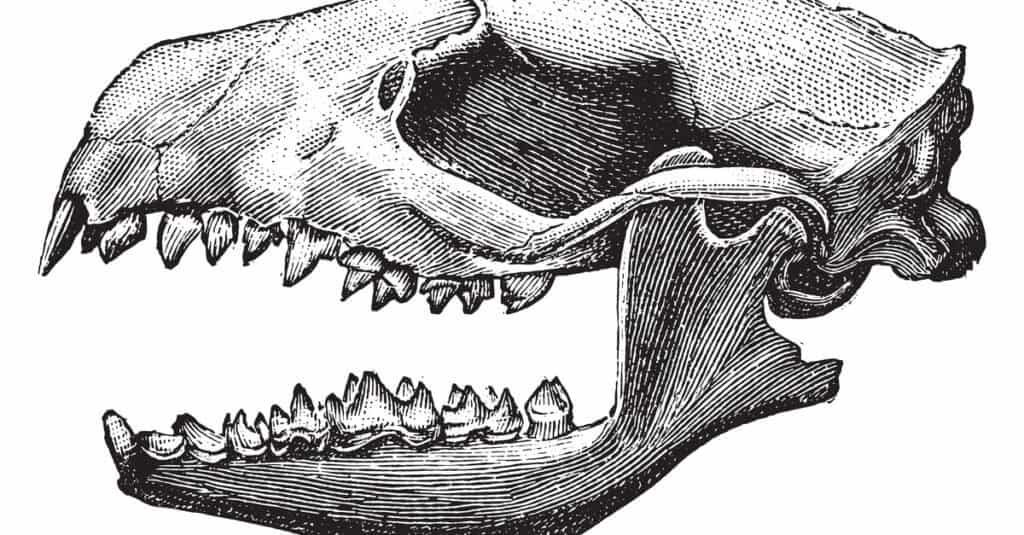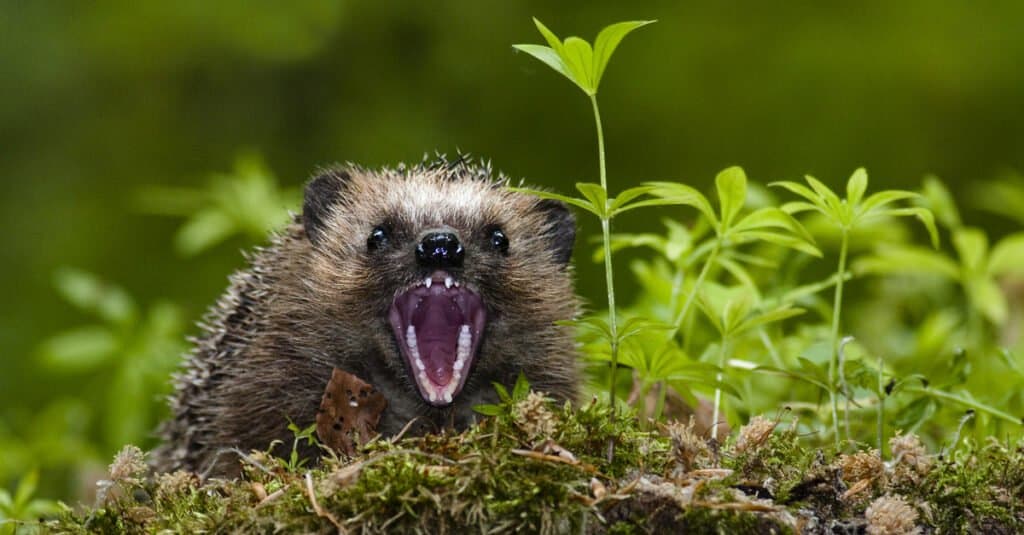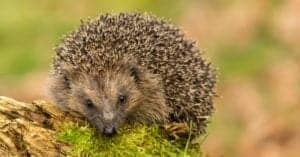Hedgehog Teeth: Everything You Need to Know
Hedgehogs are one of the most odd-looking mammals out there, with their tiny size and spiky spines covering their body. Yet, it is also undeniable that hedgehogs are one of the cutest animals on the planet and that is why many individuals choose to keep them as pets. However, many states in America do not allow pet ownership of hedgehogs.
Hedgehogs are tiny creatures that can fit perfectly in the hand. They are usually found in Asian, African, and European countries. They might seem cute and tiny, which are obvious predator magnet factors. However, hedgehogs are not really that defenseless. Apart from their spiny cover, they have incredibly sharp teeth too that make catching and eating them even more difficult.
What Kind of Teeth Do Hedgehogs Have?

Dr.MYM/Shutterstock.com
Hedgehogs have a very similar dental structure with humans. They have four different types of teeth that most mammals also have: incisors, canines, premolars, and molars.
Hedgehogs are equipped with tiny, yet very sharp and pointed front teeth called incisors which they use to catch and lift their prey. Next to the incisors are canines which help them tear down their food. The premolars and molars at the middle and rear portion of the mouth help in crushing, juicing, and grinding their food before digestion. Unlike the sharp incisors and canines, these sets of molars, collectively called the “cheek teeth”, are flat and wide to further aid in crushing food.
How Many Teeth Do Hedgehogs Have?

Morphart Creation/Shutterstock.com
Like most mammals, hedgehogs normally have 34 to 44 teeth. However, since they are diphyodont like humans and dogs, baby hedgehogs, called hoglets, are not born with complete 44 teeth. The typical dental formula for hedgehogs is: Incisors 3/2; Canines 1/1; Premolars 3/2; Molars 3/3.
Diphyodont refers to animals, mostly mammals, which have temporary teeth during their young stage, then shed and replace them with permanent ones as they reach the right age. Hoglets often develop baby teeth or milk teeth at the second or third week of age. As they reach 7 to 9 weeks, their baby teeth start to fall out and new, permanent ones come up.
Hedgehogs are not immune to dental issues though, and some hedgehogs may have fewer teeth because of these dental concerns.
Are Hedgehogs’ Teeth Sharp?
Hedgehogs have sharp front teeth with pointed cusps and flat, wide molars. A hedgehog’s front teeth are sharp enough to break skin as they nip or nibble, yet their nips usually feel more of a pinch rather than a puncture wound.
Do Hedgehogs Bite?
Hedgehogs rarely bite, but there may be times when they will accidentally nip on your fingers when you are feeding them. A hedgehog’s bite is strong enough to dig through your skin, but only lightly that it cannot really puncture through flesh.
Hedgehogs may also nip when they smell something in your skin. If your hand smells like food, for instance, especially garlic, hedgehogs can explore with the smell using their mouths and nip. Other smells that hedgehogs usually nibble on are grease, soap, lotion, detergent, perfume, or fabric softeners.
As hedgehogs do not talk, they can also use nibbling or soft biting to communicate. For instance, when they want to be put down from being handled, they can take a light nip.
What Do Hedgehogs Eat?

Miroslav Hlavko/Shutterstock.com
Hedgehogs are insectivores, which means they eat mostly insects, but they can also eat ground-dwelling animals like snails. Most hedgehogs eat a diet that comprises caterpillars, beetles, earwigs, millipedes, earthworms, termites, moths, and others. Along with invertebrates, they also eat vegetables, fruits, grass, leaves, seeds, and roots.
Some species of hedgehogs, such as those who settle in African deserts, also scavenge dead animals and smaller prey such as rodents, scorpions, and snakes. South African hedgehogs can also feed on lizards and frogs. Apart from their defensive spines, which they use to frighten away predators, they also have a unique immunity against toxins, which makes them predators for poisonous animals such as snakes, scorpions, and bees. Seems like these cute animals are not as innocent as they look after all!
Common Dental Problems

Marek Novak/Shutterstock.com
Hedgehogs are not immune to dental issues and diseases, and these problems can lead to serious conditions when ignored or left untreated. Most hedgehog owners do not regularly brush their pet hedgehog’s teeth, yet their teeth still need to be professionally cleaned and checked by an exotic pet veterinarian.
Naturally, the tough exoskeletons of insects that hedgehogs eat are filled with fibers that help them clean their teeth organically. However, when they are kept as pets, they still need their teeth checked, as they may not be consuming the exact amount of insects that can effectively clean their teeth. This can cause tartar and plaque build-up for most hedgehogs. Poor dental care for hedgehogs can cause more serious dental conditions and loss of teeth.
The tartar and plaque that usually builds up in a hedgehog’s mouth when not taken care of well is caused by bacteria and combination of saliva and food particles. These bacteria and other components sit along the gum lines which connect to the hedgehog’s blood supply, allowing the bacteria to be dispersed throughout the body organs. This process can lead to systemic infection if left unattended to.
How to Care for A Hedgehog’s Teeth
Since plaque and tartar is one problem you would want to get rid of or prevent for your pet hedgehog, brushing your hedgehog’s teeth is quite crucial. However, brushing them the normal way with toothpaste is not advisable. You can brush them using a wet Q-tip, gently rubbing their teeth at the back molars and on each side of the jaw. Plaque and tartar build-up, however, are quite difficult to scrape off without professional help.
More from A-Z Animals
Hedgehogs are one of the most odd-looking mammals out there, with their tiny size and spiky spines covering their body. Yet, it is also undeniable that hedgehogs are one of the cutest animals on the planet and that is why many individuals choose to keep them as pets. However, many states in America do not allow pet ownership of hedgehogs.
Hedgehogs are tiny creatures that can fit perfectly in the hand. They are usually found in Asian, African, and European countries. They might seem cute and tiny, which are obvious predator magnet factors. However, hedgehogs are not really that defenseless. Apart from their spiny cover, they have incredibly sharp teeth too that make catching and eating them even more difficult.
What Kind of Teeth Do Hedgehogs Have?

Dr.MYM/Shutterstock.com
Hedgehogs have a very similar dental structure with humans. They have four different types of teeth that most mammals also have: incisors, canines, premolars, and molars.
Hedgehogs are equipped with tiny, yet very sharp and pointed front teeth called incisors which they use to catch and lift their prey. Next to the incisors are canines which help them tear down their food. The premolars and molars at the middle and rear portion of the mouth help in crushing, juicing, and grinding their food before digestion. Unlike the sharp incisors and canines, these sets of molars, collectively called the “cheek teeth”, are flat and wide to further aid in crushing food.
How Many Teeth Do Hedgehogs Have?

Morphart Creation/Shutterstock.com
Like most mammals, hedgehogs normally have 34 to 44 teeth. However, since they are diphyodont like humans and dogs, baby hedgehogs, called hoglets, are not born with complete 44 teeth. The typical dental formula for hedgehogs is: Incisors 3/2; Canines 1/1; Premolars 3/2; Molars 3/3.
Diphyodont refers to animals, mostly mammals, which have temporary teeth during their young stage, then shed and replace them with permanent ones as they reach the right age. Hoglets often develop baby teeth or milk teeth at the second or third week of age. As they reach 7 to 9 weeks, their baby teeth start to fall out and new, permanent ones come up.
Hedgehogs are not immune to dental issues though, and some hedgehogs may have fewer teeth because of these dental concerns.
Are Hedgehogs’ Teeth Sharp?
Hedgehogs have sharp front teeth with pointed cusps and flat, wide molars. A hedgehog’s front teeth are sharp enough to break skin as they nip or nibble, yet their nips usually feel more of a pinch rather than a puncture wound.
Do Hedgehogs Bite?
Hedgehogs rarely bite, but there may be times when they will accidentally nip on your fingers when you are feeding them. A hedgehog’s bite is strong enough to dig through your skin, but only lightly that it cannot really puncture through flesh.
Hedgehogs may also nip when they smell something in your skin. If your hand smells like food, for instance, especially garlic, hedgehogs can explore with the smell using their mouths and nip. Other smells that hedgehogs usually nibble on are grease, soap, lotion, detergent, perfume, or fabric softeners.
As hedgehogs do not talk, they can also use nibbling or soft biting to communicate. For instance, when they want to be put down from being handled, they can take a light nip.
What Do Hedgehogs Eat?

Miroslav Hlavko/Shutterstock.com
Hedgehogs are insectivores, which means they eat mostly insects, but they can also eat ground-dwelling animals like snails. Most hedgehogs eat a diet that comprises caterpillars, beetles, earwigs, millipedes, earthworms, termites, moths, and others. Along with invertebrates, they also eat vegetables, fruits, grass, leaves, seeds, and roots.
Some species of hedgehogs, such as those who settle in African deserts, also scavenge dead animals and smaller prey such as rodents, scorpions, and snakes. South African hedgehogs can also feed on lizards and frogs. Apart from their defensive spines, which they use to frighten away predators, they also have a unique immunity against toxins, which makes them predators for poisonous animals such as snakes, scorpions, and bees. Seems like these cute animals are not as innocent as they look after all!
Common Dental Problems

Marek Novak/Shutterstock.com
Hedgehogs are not immune to dental issues and diseases, and these problems can lead to serious conditions when ignored or left untreated. Most hedgehog owners do not regularly brush their pet hedgehog’s teeth, yet their teeth still need to be professionally cleaned and checked by an exotic pet veterinarian.
Naturally, the tough exoskeletons of insects that hedgehogs eat are filled with fibers that help them clean their teeth organically. However, when they are kept as pets, they still need their teeth checked, as they may not be consuming the exact amount of insects that can effectively clean their teeth. This can cause tartar and plaque build-up for most hedgehogs. Poor dental care for hedgehogs can cause more serious dental conditions and loss of teeth.
The tartar and plaque that usually builds up in a hedgehog’s mouth when not taken care of well is caused by bacteria and combination of saliva and food particles. These bacteria and other components sit along the gum lines which connect to the hedgehog’s blood supply, allowing the bacteria to be dispersed throughout the body organs. This process can lead to systemic infection if left unattended to.
How to Care for A Hedgehog’s Teeth
Since plaque and tartar is one problem you would want to get rid of or prevent for your pet hedgehog, brushing your hedgehog’s teeth is quite crucial. However, brushing them the normal way with toothpaste is not advisable. You can brush them using a wet Q-tip, gently rubbing their teeth at the back molars and on each side of the jaw. Plaque and tartar build-up, however, are quite difficult to scrape off without professional help.






